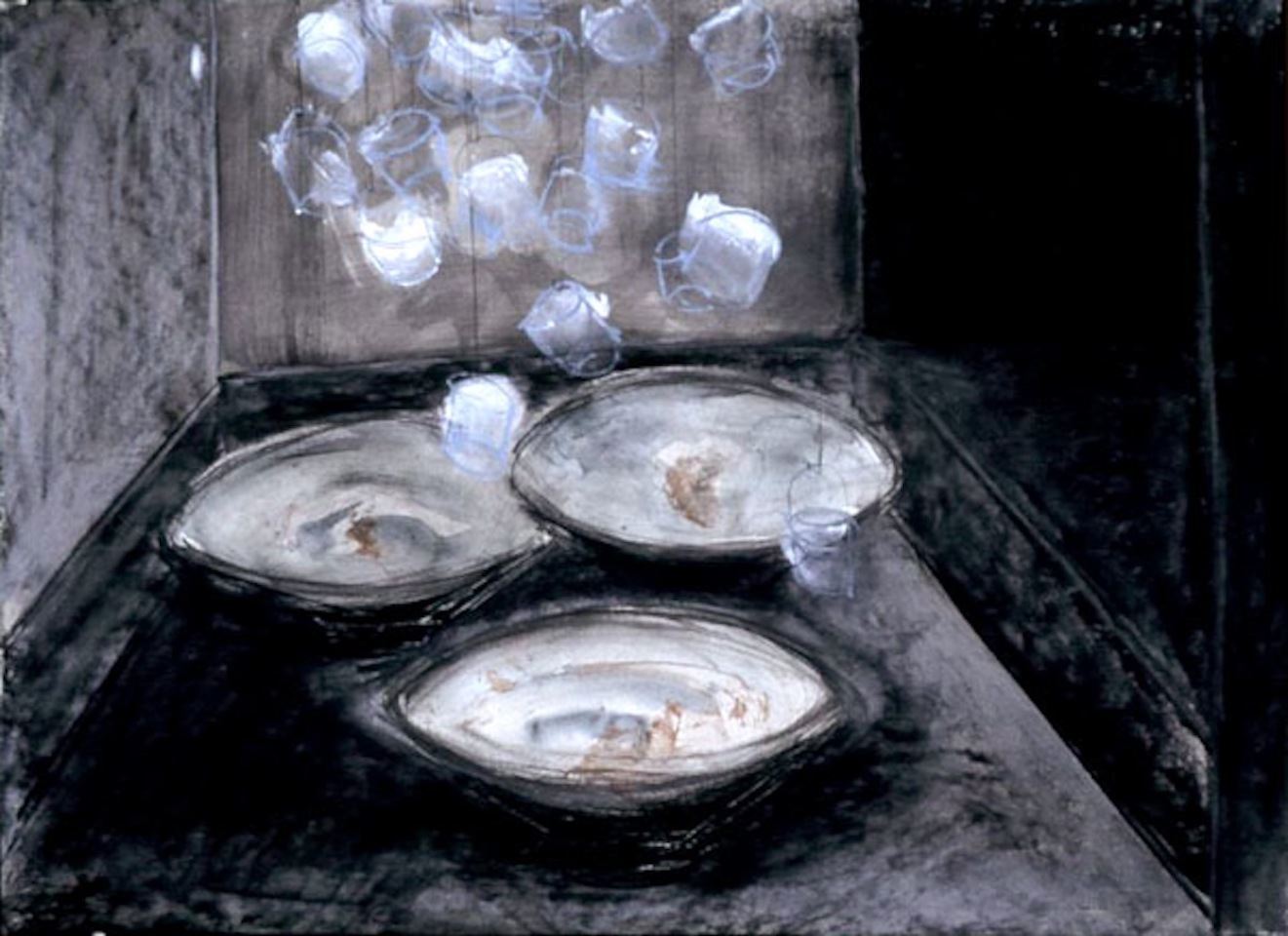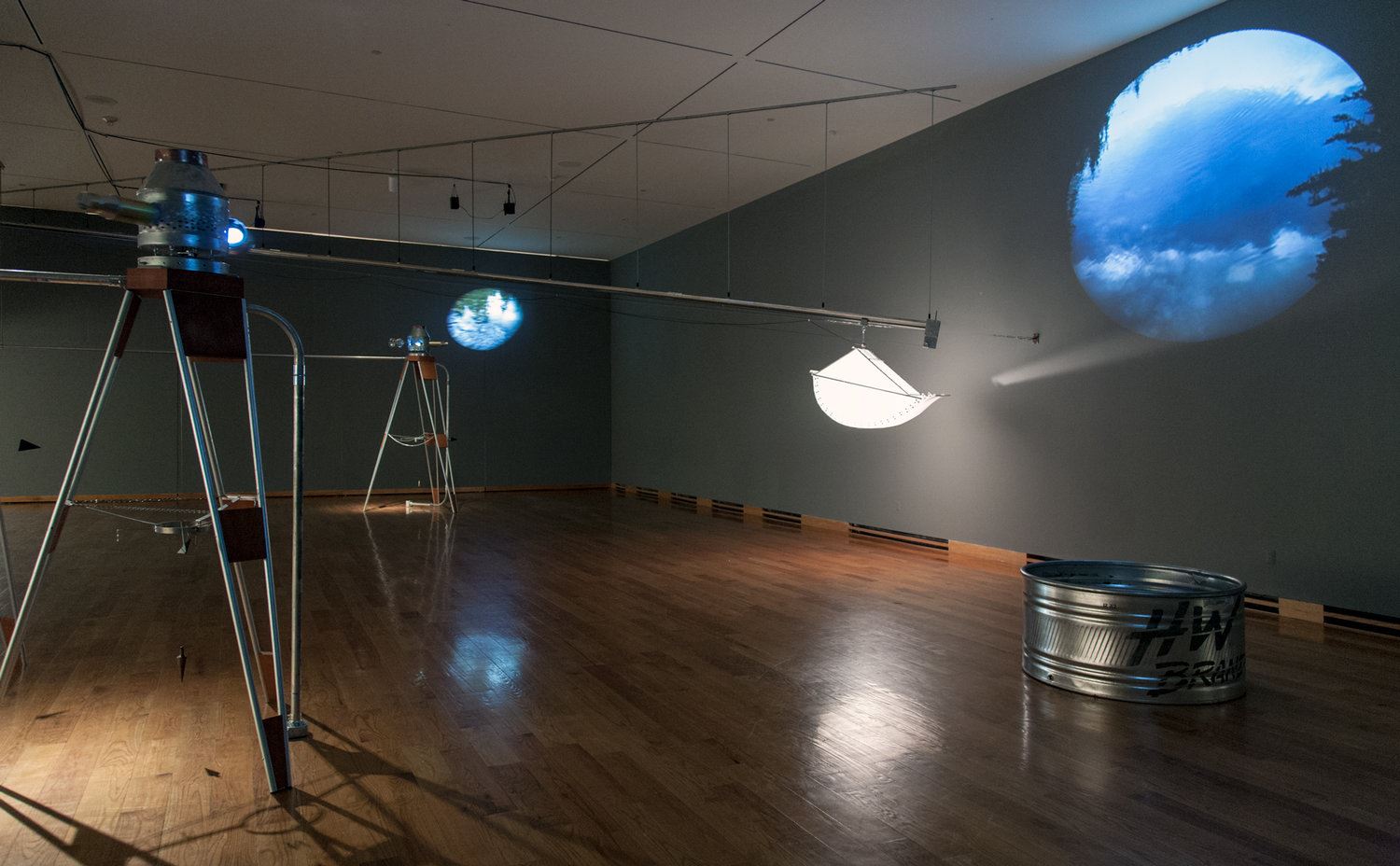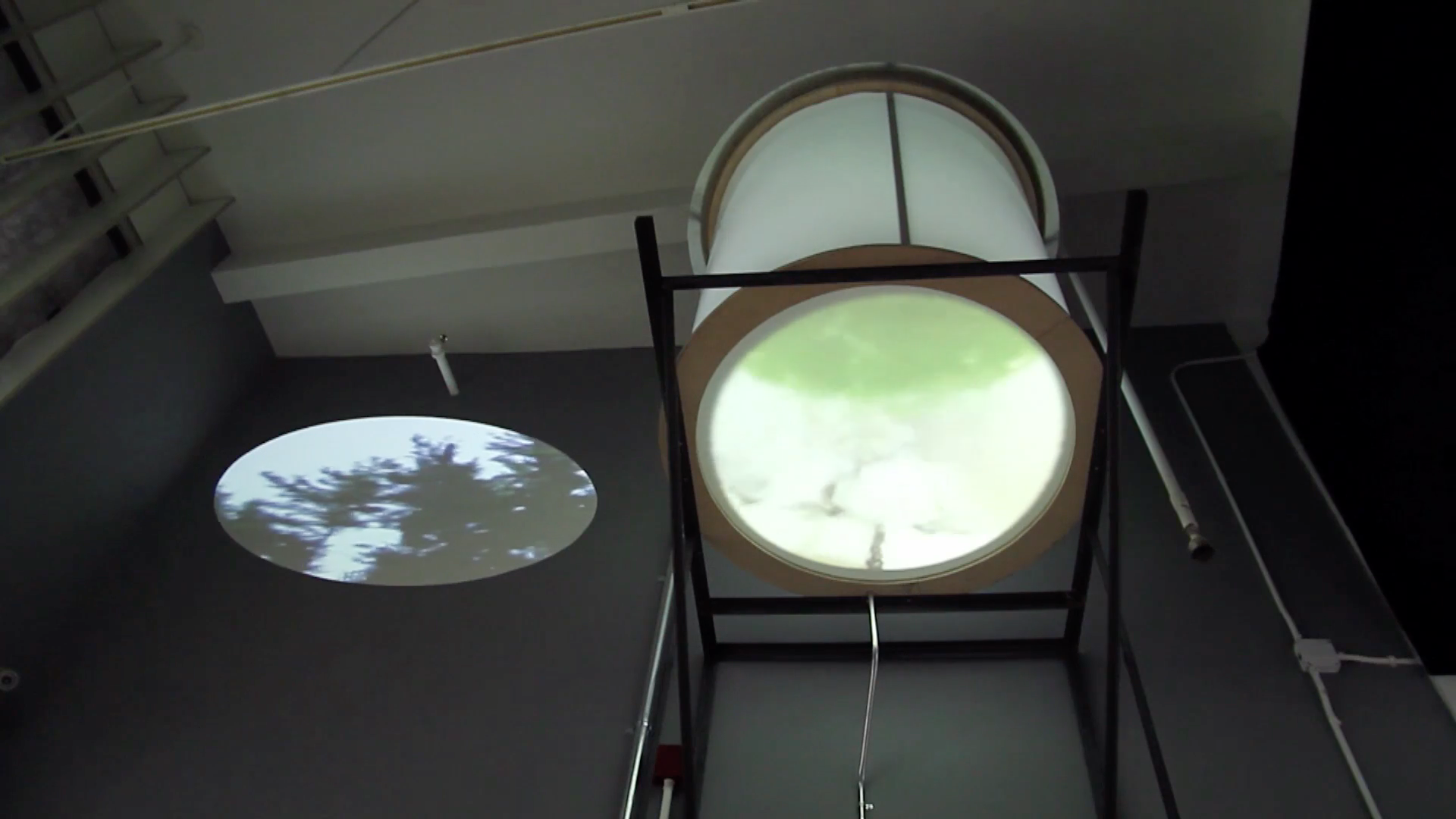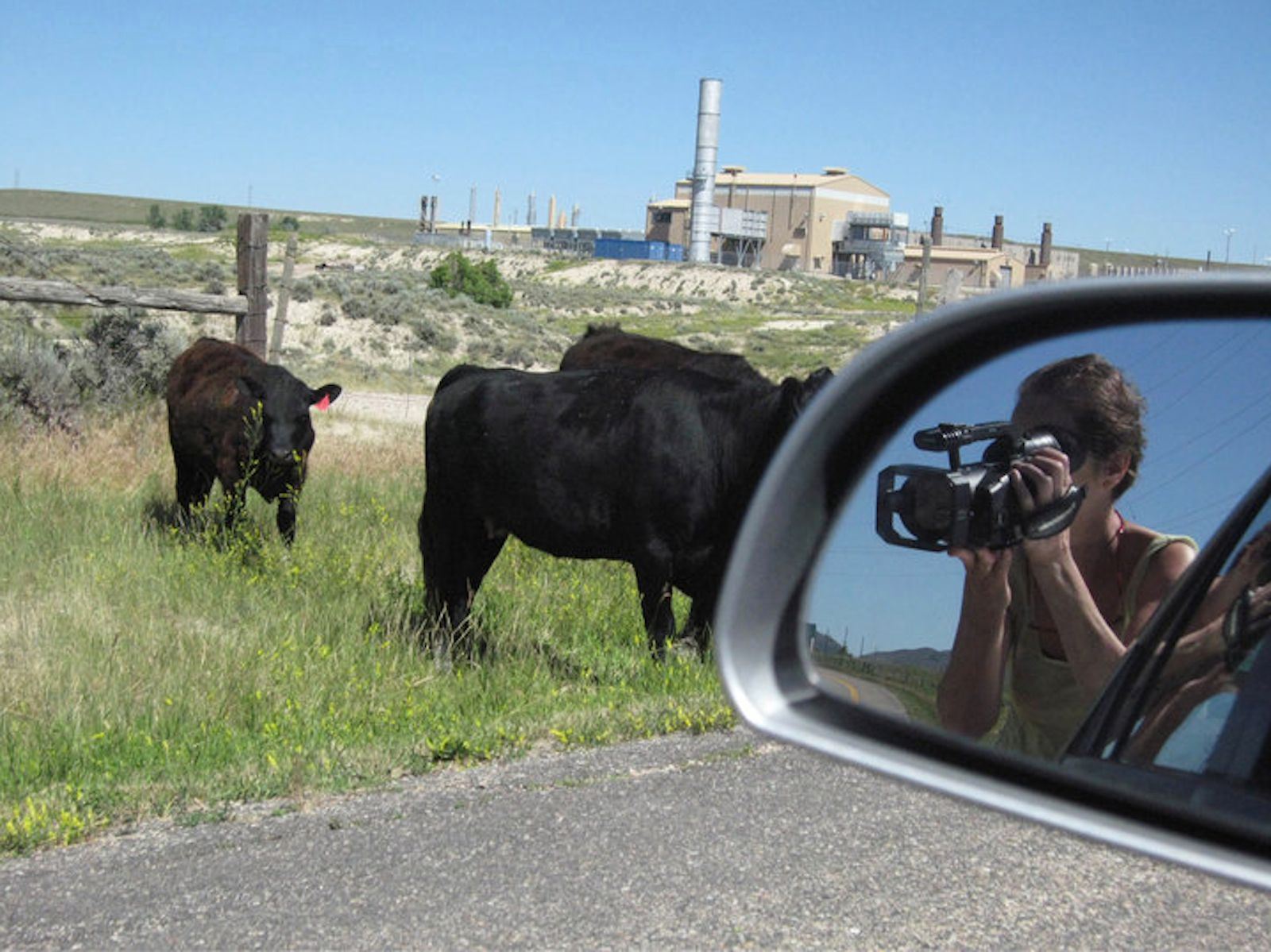
MEMBER SPOTLIGHT
August 7, 2023
This week we recognize Margaret Cogswell, and her ongoing series of RIVER FUGUES that began twenty years ago.
River Fugues are unique projects exploring the interdependency of people, industry and rivers. Each entail regional research, recording images and narratives with audio/video that are later edited into fugues and integrated into sculptural installations. The reason for using the fugue is because of its flexibility as a conceptual framework, which can be applied to any set of components one is trying to integrate, be they sounds, voices, narratives or images.
A precursor that influenced the River Fugue series, Thirst (above, a proposal drawing), installations exhibited in1999 & 2001, explored the idea of immortality being found in the waters of a particular place and/or through particular rituals involving water, including the Japanese tea ceremony, as well as the art of dowsing for water using divining rods. In both installations, dripping water turned to steam as it hit heated steel discs so that, just as with the fountain of youth, the waters are never accessible for drinking, and immortality remains elusive.
click images for more info

Lured by fire, water and the imposing presence of volcanic steel mills, during a residency at SPACES Gallery in Cleveland, Ohio, at the mouth of the Cuyahoga River, Cogswell’s site-specific response became Cuyahoga Fugues, 2003 (above), a mixed-media installation inspired by and incorporating generations of stories reflecting the life and dreams embodied by the Cuyahoga River. Struck by the interdependence of the life of the river, people and industry to each other, and the realization that her installation would include multiple audio and video components, Cogswell turned to the musical structure of the fugue as a guide for editing the video and audio. Narratives recorded from people living and working along the river, video from along the Cuyahoga River and the steel mill industry were woven together as “fugues” to become Cuyahoga Fugues. Videos and narratives were rear-projected from inside steel and plexi-pipes, as well as from vents in walls, a re-purposed radio and TV. This installation was also included in River Fuges (2007-2008), as part of Melting Ice / A Hot Topic, a traveling exhibition organized by Art Works for Change.

Mississippi River Fugues, 2008 (above) was a solo exhibition at the Art Museum of the University of Memphis in Tennessee. Entering the museum’s lobby, the viewer is surrounded by voices of cotton farmers, river guides, levee supervisors and others telling their stories which are emerging from hurricane lanterns. An 18th century French drawing of a "machine dredger" powered by men in squirrel wheel cages inspires the main installation. Entering the darkened gallery, the viewer is dwarfed by 2 giant squirrel wheels and 5 buoys. Inside the giant wheels (standing 15 and 20 ft. high) are video projections (10 ft. and 6 ft. diameter) of a man running endlessly, seemingly powering the dredger’s wheels. Each of the five buoys (6 to 14 ft. high) houses an oscillating motor and video projector in the top section. Oscillating 90 degrees, video images move across the surrounding walls and form a visual fugue exploring the haunting history, poignant beauty and delicate balance found in the interdependence of the lives of people in the Delta, the cotton industry and Mississippi River.

Wyoming River Fugues, 2012 (above) explores the complex relationship between Wyoming's natural, cultural, historic, engineered and industrial landscapes. Of particular interest are water rights and issues related to river water usage including irrigation and mining. This mixed-media installation is comprised of video projected from three surveyor’s transits, and onto the floor of a stock tank. A “bucket of light” moves slowly 50 feet diagonally across the museum’s gallery space. Surveyor’s transits, normally determining division of land and access to water, serve as a vehicle for exploring the historical and cultural landscape of Wyoming through video projections moving across the surrounding walls. Narrative fugues were created from interviews with Arapaho and Shoshone elders, botanists, composers, archaeologists, ecologists, hydrologists, philosophers, ranchers, historians, environmentalists, poets, and scientists with the extraction industries.
Moving the Water(s): Ashokan Fugues, 2014 (below) is a research-based mixed-media installation that explores the New York City water supply and its relationship to the Catskill Watershed. It was an elegy to the people of the Catskills who lost their land and homes through eminent domain for the building of the Ashokan Reservoir, which supplies drinking water for New York City through its aqueduct system. Using the musical structure of a fugue, the piece is “composed” to be played by a trio of videos projected inside the two water towers and from the one surveyor’s transit. A green ball animates the water currents and becomes the visual thread linking the movement of water from the Catskills down to NYC. The work was installed for a solo exhibition at Cue Art Foundation in New York City.

Moving the Waters: Croton Fugues, 2017 (below) was inspired by the 2017 centennial anniversary of New York City’s aqueduct system, and the location of the Mid-Manhattan Library across the street from the site of the former Croton Distribution Reservoir, the first reservoir in New York City. When that reservoir became inadequate, the City looked north to the Catskills for its water. The Croton Distribution Reservoir was then destroyed and the current New York City Public Library was built over the site. Layers of this history were reflected in the windows of the Mid-Manhattan Library across the street. This project seeks to entice the viewer into imagining and investigating the history of NYC’s water supply system through the accumulated layering of the experience of exploring these windows. Focusing on the Croton Reservoir, photographs and video stills from onsite research and documentation were layered with archival images from the NYPL digital files to form the window installations of panels of archival digital prints on canvas. Inspired by the structure of India’s 16th century Deccan Court paintings, each window installation is created with sections of narrative images, abstractions and repetitive patterns.

Margaret Cogswell is a mixed-media installation artist residing in New York and a recipient of numerous awards including the John Simon Guggenheim Fellowship (2009), Pollock-Krasner Foundation (2017, 1991 & 1987), New York Foundation for the Arts (2007, 1993); and Foundation for Contemporary Arts Emergency Grant (2014). Cogswell was born in Memphis, Tennessee, and raised in Japan where she lived until she was 13 years old. She received her Bachelor of Arts in English Literature from Rhodes College in Memphis, Tennessee. In 1982, she received a Master in Fine Arts in Sculpture from Mason Gross School of the Arts at Rutgers University in New Brunswick, New Jersey. Since 2003, the main focus of Cogswell's work is an ongoing series of RIVER FUGUES projects that explore the increasingly politicized role of water. RIVER FUGUES began in Cleveland, Ohio in 2002 with Cuyahoga Fugues, a mixed-media installation inspired by and incorporating generations of stories reflecting the life and dreams embodied by the Cuyahoga River. https://margaretcogswell.net
Featured images (top to bottom): ©Margaret Cogswell, Thirst, 1998, proposal drawing, watercolor, color pencil, chalk on paper, 20 x 30 inches; Cuyahoga Fugues, 2003, steel pipes, multiple video and audio components, 14 x 40 x 40 feet, Spaces Gallery, Cleveland, Ohio; Mississippi River Fugues, 2008, steel structures, multiple audio and oscillating video projections, 20 x 66 x 33 feet, Art Museum, University of Memphis, Tennessee; Wyoming River Fugues, 2012, steel and wood “surveyor’s transits,” steel stock tanks with video projections, 1 moving polyurethane “bucket of light”, multiple audio and oscillating video components, 16 X 64 X 37 feet, Art Museum, University of Wyoming, Laramie; Moving the Water(s): Ashokan Fugues, 2014, 2 steel & plexi “water-towers” with video and audio, 1 steel and wood surveyor’s transit and wall video projection, 15 x 13 x 15 feet, CUE Art Foundation, New York City; Moving the Water(s): Croton Fugues, 2017, window installations of archival prints on canvas, window dimensions 10 x 6 feet, Mid-Manhattan Library, New York City; self-portrait of the artist in Wyoming.
